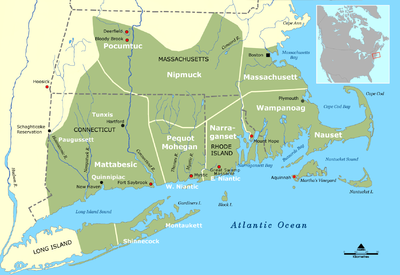- Massachusett people
-
Massachusett Total population 3000+ Languages Related ethnic groups other Algonquian peoples
- This article is about the Native American tribe. For the U.S. state, see Massachusetts.
The Massachusett are a tribe of Native Americans who lived in areas surrounding Massachusetts Bay in what is now the Commonwealth of Massachusetts, in particular present-day Greater Boston; they spoke the Massachusett language. The present-day U.S state Massachusetts is named after the tribe.
Alternate forms are Moswetuset, as in the Moswetuset Hummock where Myles Standish and Squanto first met Chief Chickatawbut in 1621,[1] and Massachusit, as in the Massachusit Fields where Captain Richard Wollaston brought the first settlers of Quincy Massachusetts in 1624.[2] "Massachusett" translates from Algonquian as "The people who live near the great hill", while "Moswetuset" translates to "The hill shaped like an arrowhead". The former is thought to refer to the Blue Hills located south of Boston, while the latter most definitely refers to the Moswetuset Hummock.
One of the first groups of indigenous American peoples to encounter English colonists, their numbers were quickly depleted, although descendants continue to inhabit the Greater Boston area. The Massachusett belong to the Algonquian family of peoples.
Contents
Roots in pre-history
The Massachuset people are most likely descendants of early people who lived in eastern North America at the end of the last glaciation 30,000-15,000 years before present (BP). Archeological evidence (spear points, midden mounds) uncovered in Boston indicate habitation in that area between 6,500 and 8,000 years BP. Fishing structures, the Boylston Street Fishweir, dating to 5,200 years BP have been discovered in what is now Boston's Back Bay neighborhood. A recreation of a fish weir is erected annually on Boston Common in May. These early people lived a seasonally migratory existence, alternating between inland hunting grounds in the fall and winter, to coastal fishing and foraging sites in the late spring and summer and winter homes inland.
Historical period, contact with European colonists
The Massachuset and other Algonquian tribal groups were almost totally wiped out by a European-introduced plague between 1616 and 1619,[3] and the remaining population was scattered in the wake of the invasion of the English. A murder of two Massachusett military leaders led by Captain Miles Standish of Plymouth Colony in 1623 led to the avoidance of these invaders.[4] A period known as the Great Migration between 1630 and 1640 introduced over 20,000 English settlers to the Massachusett territory.[5] Though much diminished in size and strength from their numbers before the arrival of English colonists, the Massachusett Indians were documented to have participated in King Philip's War of 1675-1676.[6]
Colonial records show that during the early 17th century the Massachuset fished the shores and farmed the lands, migrating from longhouses on the coast to wigwam settlements inland for farming. The tribes were introduced to John Eliot, who converted some of them to Christianity, created a written alphabet, and published the Bible in the native language. The tribe was confined by English law to praying villages and later suffered at the hands of colonists, who mistrusted the Indians after King Philip's War, despite the fact that Massachusett Indians had served as guides and scouts. Many perished in the islands in Boston Harbor, where they were confined. Crispus Attucks, the first casualty during the Boston Massacre was of Massachusett descent through his mother.[7]
After 1869
In 1869 Massachusetts passed an act making the Massachusett United States citizens and "terminating" their nationhood. Communities still survive:
- One community of the Massachusett are residents of Natick. See Praying Indians.
- One community of the Massachusett are residents of Brockton. They are Ponkapoag.[8] (Another community of the Ponkapoag were residents of Canton. One of the alleged last members of this community died in 1852 at age 101.[9])
The descendants still exist, once again as a group organized as the Massachuset-Ponkapoag Tribal Council.[8]
See also
References
- ^ Discover Quincy: Attractions
- ^ Pepe, William J.; Elaine A. Pepe (2008). Quincy Postcard History Series. Arcadia Publishing. pp. 127. http://books.google.com/books?id=NBQrnXx79-UC&printsec=frontcover.
- ^ Philbrick, Nathaniel (2006). Mayflower. New York: Penguin Group. pp. 78–80. ISBN 0-670-03760-5.
- ^ Philbrick (2006) pp 154-155
- ^ Taylor, Norris (1998). "The Massachusetts Bay Colony". http://members.aol.com/ntgen/hrtg/mass.html. Retrieved 2007-03-30.
- ^ Philbrick (2006) pp 219
- ^ "Massachuset History". First Nations/First Peoples issues. Jordan S. Dill. http://www.dickshovel.com/massa.html. Retrieved 2007-03-30.
- ^ a b "The Massachuset People (at Ponkapoag)HOME PAGE". Ponkapoag Tribal Council. http://Neponsett.org. Retrieved 2007-03-30.
- ^ Canton Massachusetts Historical Society "Canton Historical Society". http://www.canton.org/native/ Canton Massachusetts Historical Society. Retrieved 2007-03-30.
External links
Categories:- Algonquian peoples
- Native American history of Massachusetts
- Native American tribes in Massachusetts
- Algonquian ethnonyms
Wikimedia Foundation. 2010.

